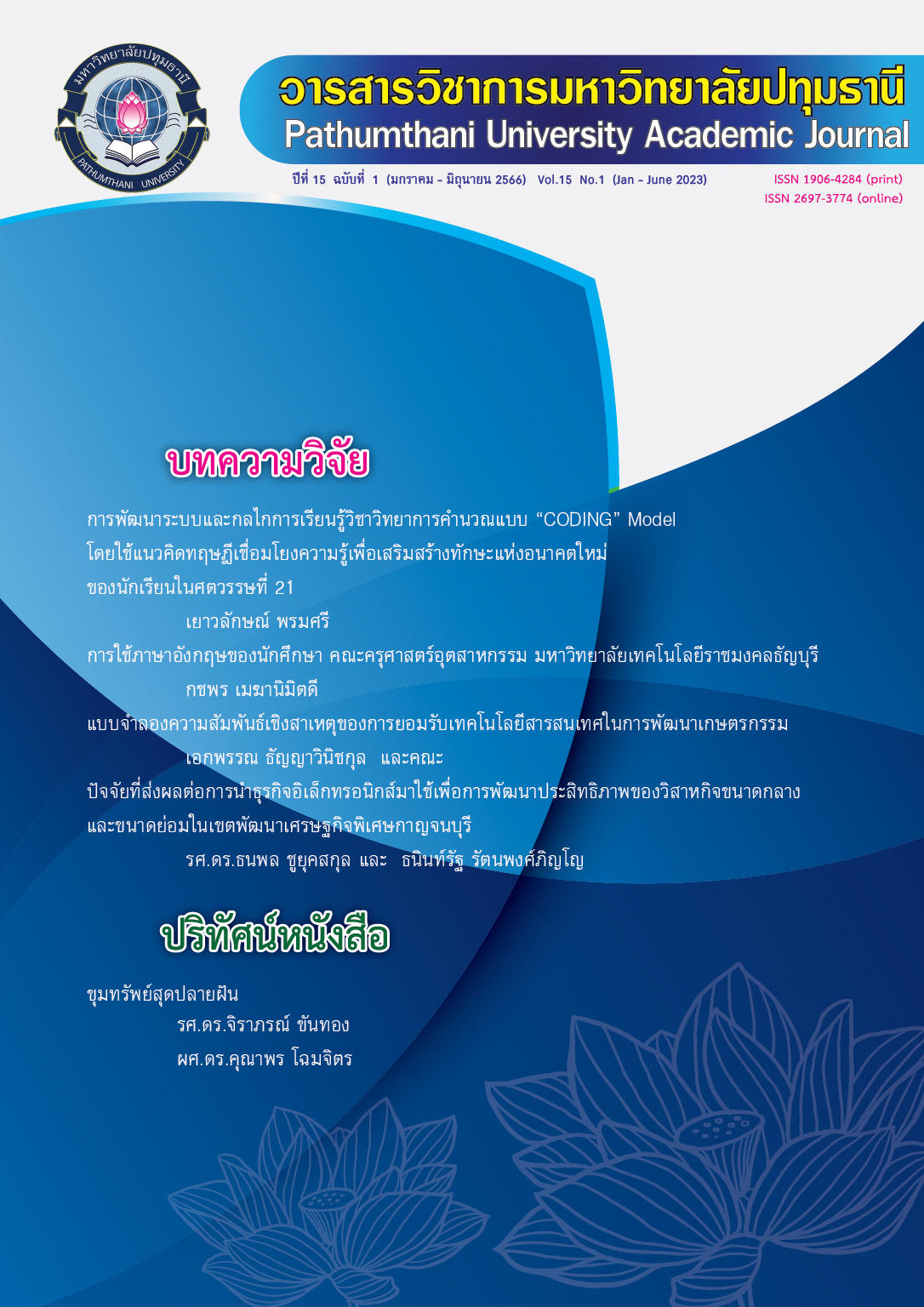CAUSAL RELATIONSHIP MODEL OF INFORMATION TECHNOLOGY IN ADOPTION OF AGRICULTURAL DEVELOPMENT
Keywords:
Information Technology Adoption , Agriculture, FarmerAbstract
The objectives of this research were 1) to test the consistency of the causal relationship model of factors influencing the acceptance of information technology in agricultural development of rice farmers with empirical data, and 2) to study the weight of direct influence, indirect influence, and the total influence of the factors studied towards the acceptance of information technology in agricultural development. The samples consisted of rice farmers in Chainat Province, 482 people. The key informants included farmers, local leaders and government officials totaling 28 people.
The results revealed that 1) a causal relationship model of factors influencing the acceptance of information technology in agricultural development of rice farmers are consistent with empirical data with the relative chi-square equal to 1.73, GFI=.99, CFI=.99, NFI=.99, RMR=.01, RMSEA=.04 and 2) behavioral intent influenced by the highest information quality factor and price value with statistical significance at the .01 level, followed by performance expectation factor with a statistical significance at the .05 level. The reliability ratio of agricultural information technology acceptance variables explained by causal factors was 75.8% (R2=.75), and the price value factor had a positive influence on behavioral intention, with experience as a modurate variable, with statistical significance at the .05 level.
References
คณะกรรมาธิการการเกษตรและสหกรณ์. (2564) .รายงานการพิจารณาศึกษา เรื่อง การขับเคลื่อนเกษตรกรปราดเปรื่อง (Smart Farmer) ภายใต้แผนการปฏิรูปประเทศและยุทธศาสตร์ชาติ 20 ปี. กรุงเทพมหานคร : ผู้แต่ง.
ชุมแพร บุญยืน และคนอื่น ๆ. (2561). “ทฤษฎีการยอมรับการใช้เทคโนโลยีสารสนเทศ.” วารสารช่อพะยอม. ปีที่ 29 ฉบับที่ 1. หน้า 359-357.
พลสราญ สราญรมย์. (2562). “การใช้เทคโนโลยีสารสนเทศเพื่อการผลิตปาล์มน้ำมันของเกษตรกรในจังหวัดกระบี่”. วารสารอิเล็กทรอนิกส์การเรียนรู้ทางไกลเชิงนวัตกรรม. ปีที่ 9 ฉบับที่ 1. หน้า 155-163.
วิษณุ อรรถวานิช และคนอื่น ๆ. (2565). การจัดทำข้อเสนอแนะนโยบายการเกษตรดิจิทัลเพื่อสนับสนุนการฟื้นตัวจากผลกระทบของ COVID-19 สำหรับประเทศไทย. [ออนไลน์]. เข้าถึงได้จาก: https://www.moac.go.th/foreignagri-news-files-441091791116
สินีนุช ครุฑเมือง แสนเสริม และคนอื่น ๆ. (2564). การใช้เทคโนโลยีสารสนเทศเพื่อการผลิตพืชเศรษฐกิจของเกษตรกร. วารสารเกษตร มสธ. ปีที่ 3 ฉบับที่ 1. หน้า 31-44.
โสมรัศมิ์ จันทรัตน์ และคนอื่น ๆ. (2562). ภูมิทัศน์ภาคเกษตรไทย จะพลิกโฉมอย่างไรสู่การพัฒนาที่ยั่งยืน. [ออนไลน์]. เข้าถึงได้จาก: https://www.bot.or.th/Thai/ResearchAndPublications/articles/Pages/ Article_26Sep2019.aspx
Beza, E., Reidsma, P., Poortvliet, M., Belay, M.M., Bijen, B.S., Kooistra, L. (2018). “Exploring farmers’ intentions to adopt mobile Short Message Service (SMS) for citizen science in agriculture”. Computers and Electronics in Agriculture. Vol 151. pp. 295-310.
Caffaro, F. , Cremasco, M.M., Roccato, M., Cavallo, E. (2020). “Drivers of farmers’ intention to adopt technological innovations in Italy: The role of information sources, perceived usefulness, and perceived ease of use”. Journal of Rural Studies. Vol 76. pp. 264-271.
DeLone, W. H., & McLean, E. R. (2003). “The DeLone and McLean Model of Information Systems Success: A Ten-Year Update”. Journal of Management Information Systems. Vol 19. No 4. pp. 9-30.
Kante, M., Oboko, R. and Chepken, C. (2019). “An ICT model for increased adoption of farm input information in developing countries: A case in Sikasso, Mali”. Information Processing in Agriculture. Vol 6. pp. 24-46.
Michels, M., Bonke, V., and Muhoff, O. (2020). “Understanding the adoption of smartphone apps in crop protection”. Precision Agric. Vol 21. pp. 1209-1226.
Gloy, B. A. and Akridge, J. T. (2000). “Computer and Internet adoption on large U.S. farms”. Internatial Food and Agribusiness Management Review, Vol 3. No. 3. pp. 323-338.
Molina-Maturano, J., Verhulst, N., Tur-Cardona, J., Güerena, D.T., Monsalve, A.G., Govaerts, B., Speelman, S. (2021). Understanding smallholder farmers’ intention to adopt agricultural apps: the role of mastery-approach and innovation hubs. Agronomy 2021. Vol 11. No. 2. pp. 194.
Rose, D.C., Sutherland, W.J. , Parker, C., Lobley, M., Winter, M., Morris, C., Twining, S., Ffoulkes, C., Amano, T., Dicks, L.V. (2016). “Decision support tools for agriculture: Towards effective design and delivery”. Agricultural Systems. Vol 149. pp. 165-174.
Stevens, J. P. (2002). Applied Multivariate Statistics for the Social Sciences. (4th ed.). Mahwah, New Jersey: Lawrence Erlbaum Associates, Inc., Publishers.
Taylor, W. J., Zhu, G. X., Dekkers, J., & Marshall, S. (2003). “Factors affecting home internet use in Central Queensland.” In Proceedings of the 2003. Information Science and Information Technology Education Conference, Pori, Finland, Vol 3. pp. 573-588.
Watkins, A. & Ehst, M. (2008). Science, Technology, and Innovation: Capacity Building for Sustainable Growth and Poverty Reduction. World Bank. [Online]. From: https://openknowledge.worldbank.org/handle/10986/6418
Downloads
Published
How to Cite
Issue
Section
License
Copyright (c) 2023 เอกพรรณ ธัญญาวินิชกุล, ปิยพร ท่าจีน, ประภาส จงสถิตวัฒนา

This work is licensed under a Creative Commons Attribution-NonCommercial-NoDerivatives 4.0 International License.
บทความที่ได้รับการตีพิมพ์เป็นลิขสิทธิ์ของวารสารมหาวิทยาลัยปทุมธานี
ข้อความที่ปรากฎในบทความแต่ละเรื่อง เป็นความคิดเห็นส่วนตัวของผู้เขียน กองบรรณาธิการไม่จำเป็นต้องเห็นด้วยเสมอไป และไม่มีส่วนรับผิดชอบใด ๆ ถือเป็นความรับผิดชอบของผู้เขียนแต่เพียงผู้เดียว



